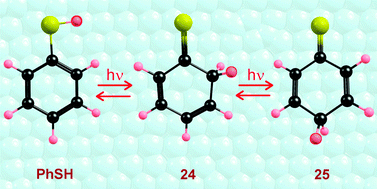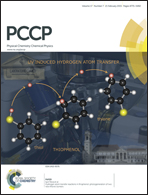Hydrogen atom transfer reactions in thiophenol: photogeneration of two new thione isomers†
Abstract
Photoisomerization reactions of monomeric thiophenol have been investigated for the compound isolated in low-temperature argon matrices. The initial thiophenol population consists exclusively of the thermodynamically most stable thiol form. Phototransformations were induced by irradiation of the matrices with narrowband tunable UV light. Irradiation at λ > 290 nm did not induce any changes in isolated thiophenol molecules. Upon irradiation at 290–285 nm, the initial thiol form of thiophenol converted into its thione isomer, cyclohexa-2,4-diene-1-thione. This conversion occurs by transfer of an H atom from the SH group to a carbon atom at the ortho position of the ring. Subsequent irradiation at longer wavelengths (300–427 nm) demonstrated that this UV-induced hydrogen-atom transfer is photoreversible. Moreover, upon irradiation at 400–425 nm, the cyclohexa-2,4-diene-1-thione product converts, by transfer of a hydrogen atom from the ortho to para position, into another thione isomer, cyclohexa-2,5-diene-1-thione. The latter thione isomer is also photoreactive and is consumed if irradiated at λ < 332 nm. The obtained results clearly show that H-atom-transfer isomerization reactions dominate the unimolecular photochemistry of thiophenol confined in a solid argon matrix. A set of low-intensity infrared bands, observed in the spectra of UV irradiated thiophenol, indicates the presence of a phenylthiyl radical with an H- atom detached from the SH group. Alongside the H-atom-transfer and H-atom-detachment processes, the ring-opening photoreaction occurred in cyclohexa-2,4-diene-1-thione by the cleavage of the C–C bond at the alpha position with respect to the thiocarbonyl C![[double bond, length as m-dash]](https://www.rsc.org/images/entities/char_e001.gif) S group. The resulting open-ring conjugated thioketene adopts several isomeric forms, differing by orientations around single and double bonds. The species photogenerated upon UV irradiation of thiophenol were identified by comparison of their experimental infrared spectra with the spectra theoretically calculated for the candidate structures at the B3LYP/aug-cc-pVTZ level.
S group. The resulting open-ring conjugated thioketene adopts several isomeric forms, differing by orientations around single and double bonds. The species photogenerated upon UV irradiation of thiophenol were identified by comparison of their experimental infrared spectra with the spectra theoretically calculated for the candidate structures at the B3LYP/aug-cc-pVTZ level.


 Please wait while we load your content...
Please wait while we load your content...